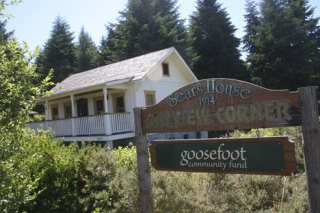BAYVIEW – Goosefoot Community Fund is selling more than 10 acres of land in Bayview — including the historic Sears House — to pay for improvements to Bayview Center.
In preparation for the first phase of changes at the shopping center located on Highway 525, Goosefoot will sell several properties at Bayview Corner valued roughly at $1 million, Goosefoot CEO Chris Hurley said earlier this week.
The proceeds from the property sales will support upgrades to the center such as an improved parking lot, new signs and landscaping. Goosefoot will launch the first phase of improvements to Bayview Center this summer.
Hurley said the Goosefoot board of directors decided on the move because they need to liquidate assets fast so the first phase of the project can start, which will cost about $1.8 million.
“We have our resources to start,” she said. “But we don’t have enough.”
The three Bayview Corner parcels owned by Goosefoot that will go on the market are:
• The Potato Field, 6.1 acres of open space at the northeast corner of Bayview and Meinhold roads;
• The Swenson Farm, 5 acres with a restored farmhouse;
• And the Sears House, a restored Sears kit house and outbuilding at the southeast corner of Bayview and Meinhold roads.
Hurley said it isn’t necessary to sell all three if they can make enough money by selling two, but they wanted to give buyers options.
“We don’t expect to sell all three,” Hurley said. “But we need to raise about $600,000.”
The Swenson Farm and Potato Field properties were chosen because they have relatively limited development potential.
“We had a few ideas for the Potato Field. It’s our favorite property,” Hurley said, adding that Goosefoot negotiated with Whidbey General Hospital to have the South Whidbey medical and emergency center built there and most recently worked with the county’s housing authority on plans for the property. Those plans never came to fruition, however.
Goosefoot also hopes to negotiate a permanent easement so parking for the Bayview Farmers Market could be preserved.
The Sears House property was picked because it has already been fully developed. The historic building has been the home of Goosefoot headquarters since 2004.
Hurley said Goosefoot has no plans yet where to relocate if the property sells.
“We decided in some ways not to worry too much,” Hurley said. “Somewhere or another, we’ll find a place for ourselves.”
The Sears House may be the money maker if sold. While the other two properties add up to major acreage, the relatively small parcel the Sears House sits on is zoned “rural center” while the other two properties are zoned “rural.” The distinction on the zoning map makes the land three to four times more expensive than the neighboring Potato Field, Hurley said.
Goosefoot did not reveal asking prices and declined to say if any potential buyers are lined up. But Hurley said there is one interested party for one of the properties and a sale could be announced within a month.
Two tenants will be affected by potential sales. The Northwest Language Academy is renting classroom space next to the Sears House and a single tenant lives on the Swenson property, Hurley said.
Goosefoot will continue to own nine acres at Bayview Corner if all three parcels are sold. This includes the Cash Store and its surrounding landscaped “campus,” the large open space bordered by Highway 525 and Bayview Road, and 3.5 acres with development potential behind the Sears House.
Goosefoot bought the eight acres of property at Bayview Center four years ago, including the retail structures.
A new challenge for Goosefoot is that the Bayview Center project be financially viable. Unlike Bayview Corner across the street, the Bayview Center project is not being bankrolled by a philanthropic gift.
Goosefoot borrowed $8 million under a market tax credit program to buy Bayview Center. The developer plans to create a total of 110,000 square feet of retail space; the shopping center currently has 32,000 square feet of retail space.
Plans for the second phase of the project are still up in the air and will be shaped by market demand and future tenants’ needs.
“The market will tell us,” said Gordy Edberg, an architect and Goosefoot’s board president. “We really are at the mercy of the market.”
While the organization hopes to maximize the build out of the property, it hopes to do it with the “Goosefoot feel.” Aesthetics, as well as environmentally-friendly buildings, are priorities.
Current businesses at Bayview Center, including Casey’s Red Apple and Neil’s Clover Patch Café, have leases that run until 2009. Sebo’s Do-It Center and the Exxon gas station are not on Goosefoot property.
If Goosefoot sells its properties, work on the center could begin later this summer with major work moving forward in early 2009.
Edberg is ready to dig in.
“It’s actually really exciting,” he said. “We are actually at a point when we are doing things.”
It’s a big job to transform the strip mall shopping center into something that can be compared with Bayview Corner.
“We want to make it a more people-friendly area,” Edberg said.
“The center is in need of old-fashioned, elbow-grease clean-up, common-sense safety and energy upgrades, as well as some creative touches. Our property sales will allow us to improve the appearance of the center and the retail strength of our merchants,” he added.
Hurley agreed.
“We talked a lot about how much love and attention Bayview Center needs,” Hurley said, adding that the center has huge potential.
“This is really the last big piece of commercial real estate on South Whidbey,” she said.
Goosefoot will hold a community meeting to talk about the sale at 6 p.m. Monday, July 21 in the Front Room in the Bayview Cash Store.



